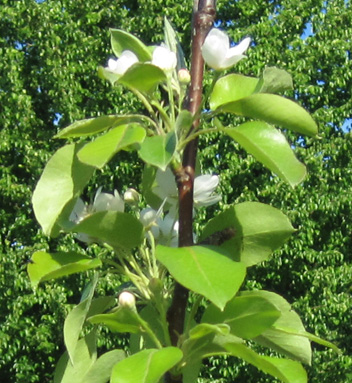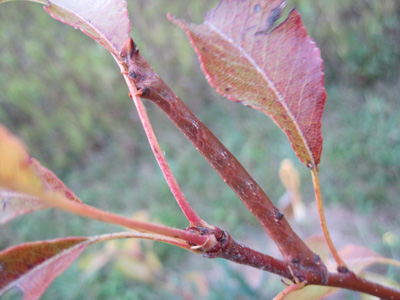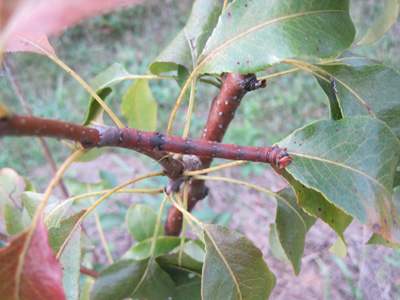|
| ||
|
Apples
Blueberries |
L'Anse Pear
Grafted 2017 on usseriensis rootstock
|
|
|
A Special Pear Usually the pears don't get their own page until they fruit, but this one is a bit special. Here's the story... September 2016 - We were at a polka dance in L’Anse and a young couple brought in a wonderful basket of beautiful medium-small pears for the snack table. My experience with pears had been pretty much limited to occasional canned ones and a handful of first small Stacey & Summercrisp pears from our young trees. Happy to have something other than sugar snacks to eat both Steve and I picked up a pear and a few cherry tomatoes. When I sat down I took a bite of the pear...Wow! I had no idea pears could taste like that. Sweet, smooth, great texture, wonderful snack size but larger than Stacey or Summercrisp. Immediately I went back to the table for another one. I wanted to know more about this pear. But this was a large lively noisy polka party and the young couple had their three young children with them to manage so in-depth conversation just wasn’t going to happen. But I found out that the trees were "old" (inherited when they bought the house), were well known in the area for decades for having good fruit, were wonderfully prolific, and they didn’t know the variety. L’Anse isd on the south shore of Lake Superior. When we left the polka party the Cadeau's encouraged us to take some of the leftover pears. Deciding not to be greedy we went out the door with four extra fruits (having enjoyed several more during the dance). I planted some of the seeds from these pears in the garden nursery bed. Suddenly I was interested in Pears. I wanted to add some to my orchard, and in particular this pear. I later emailed the couple and asked for more information about the pear, inquiring about getting some scions. Eric kindly agreed to send some. Soon I received a large envelope full of what, to others, would be a tangle of random branch cuttings but to me it contained precious scions. I sent some of my own apple scions back in trade. I again emailed and asked for more information, anything they might know about where the pear came from, and received another kind reply. Unfortunately this was after I had sorted through his generous package of scions, keeping the best looking, and tossing the rest since I didn’t need that many. After reading his later email I wished I could retrieve the other branches (the unknown second variety) but they had been tossed randomly off into the woods. And I want to bother him for more. Here is his information: "I provided you with three sets of scion wood. Two from the same pear tree and the one is from another. The set of scion wood that is unique from the other two can be identified by the very thin scion wood with the terminal buds still on them...These two thin scions with the terminal buds are likely water sprouts from the last year. ...there are two types of pears provided and these types are currently a theory as we haven't confidently identified them, perhaps as you get fruit, you can help share your observations and thoughts. Pear variety #1 - the single bundle with the thin scion wood w/ terminal buds: This type I believe is either a Forelle pear or a Tyson pear. Many of the flavor characteristics remind me of the Tyson description, however the blushing seems to give it away to a Forelle. Perhaps it is neither of these. They typically come mid August - 1st week of September. I'd have to look for some pictures or take note this year of the blossoms but I think they are pink. Fruit very sweet, hints of cinnamon and other spicy flavors. [These are the pears they had at the party and we tasted]. (Pear variety #2 - the other two bundles. I believe that these are yellow bartletts. They form large (man sized fist or larger) pears. They ripen the 1st week of September thru the 3rd week of September. They have white blossoms. They are large firm and green and then they ripen into brilliant yellow pears. Very crisp. A classic pear flavor.)
All three of our fully mature pear trees are quite old - I estimate that they
were planted in the 1940's - 1950's. They were planted and owned by the McIntyre
family of L'Anse - the [Note: The Cadeau’s sell their pears and other wonderful produce at the L’Anse Farmers Market in the summer. If you’re in the area look for them (Radicle Gardens) there, and in the fall you can buy some of their wonderful pears!].
In May we grafted 2 of the scions onto two young ussuriensis rootstocks. Both grew well, but midsummer the second rootstock died, taking the scion with it. But #1 grew a vigorous 22", healthy. We also grafted 2 scions onto our large seedling chokepear. These had light but healthy growth. I had also saved some seed from the party pears and planted those in my nursery bed. 2023 - The main small L'Anse really does want to set fruit! It had 10 blossom sets and although it has more leaves this year (thankfully) (apparently cutting off spurs last year did work) it is still too small (about waist high) so I took all but one off. It didn't produce a fruit but there was moderate (though still small) growth of wood with many side buds, and it is healthy. The two seedlings are looking better with some small growth. Grafts in the Chokepear are fairly vigorous and healthy. Grafted two more this year. Their challenge is the fireblight in the wood they are grafted to. I cut a lot out around them and am hopeful all the healthy growth, in the many grafts and in new wood, will help the entire tree overcome the fireblight. But it is quite obvious that the L'Anse is a strongly fireblight resistant variety to have survived thus far. It looks like possibly fruit buds forming - maybe next year! 202 2 - May 20 I carefully picked off 25 blossom bud spurs, leaving 16 leaf buds, some single on trunk, most next to bud spurs. It seemed drastic but it will hopefully get this slow growing small tree into vegetative growth and slow its strong desire to fruit, at least for now. It seemed to help and there was more branch growth this year. It remains healthy.The seedling in the main orchard is slowly growing, single stem 40" tall, covered with single buds. Leaves rough but alive. The one in the very lightly managed NE Orchard is doing fine. Grafts in the much challenged Chokepear continue strong and healthy. With so much of the main tree gone now they are finally getting sun and they all grew nicely, some vigorously. I cut out growth around them and tried to train them where I'd like them to go. The tree itself is rather a mess of new lanky growth due to the cutbacks so any management is rather a guessing game. 2021 - And again... This little tree just really wants to fruit! With a very warm, early spring the blossoms came almost a week earlier than last year's, but there it was again, full of blooms. And nicely for pollination it timed itself with nearby Summercrisp pear. It's still too young to set fruit but I let the blossoms go for awhile. Turns out it wasn't a problem, a stretch of low 20's freezes a week later took out any chance of fruit this year anyway. But the tree grew fine and I did some managing of the branches to get a better shape. The two smaller L'Anse seedlings did OK but had rough leaves. I don't think they particularly liked the hot summer. But the grafts on the Chokepear were the surprise kings of the orchard. In a badly fireblighted tree, last year and this, the L'Anse grafts were not only the only ones to survive, they showed no sign of disease. And with the much more thinned parent tree (see the Chokepear) the grafts grew better than they had in the past. There are three and I hope someday they will be a major part of that tree. 2020 - Blossoms again! 5/25 there were 5 blossom clusters, but this is still quite a small tree so I nipped them all off. Maybe next year! Good growth, healthy. No signs of fireblight. And the only grafts to survive on the badly fireblighted large chokepear were the L'Anse grafts! The L'Anse seedling saplings (seeds from those first pears from the Cadeau's) are both doing fine.
In June I noticed the small tree had buds! Four sets. Way too young to allow to set fruit I later nipped them all off, but first I let them open, which they did about June 11, similar in timing with Summercrisp and after chokepear and Stacey. Pretty white blossoms, so I hope Eric was wrong about the mother tree having pink blossoms. The tree again had moderate growth. The two seedlings also grew moderately and are healthy. Mid September I was walking by
the L'Anse tree and something a little odd caught my eye - a small horizontal
twig. I looked at it and it took me awhile to realize it wasn't a twig but a
very large inchworm (or are they called spanworms when that large?)! Looked
around and sure enough, there was another one. Can’t say as I’ve ever seen one
before, though considering their incredible camouflage I doubt I’d see them on a
larger tree. A little research and I found they are a type of Geometer but I
didn’t have any luck finding a good matching photo to go with a name of the
moth. This is a very large family so that's not too surprising. But these
critters sure are impressive! The next day I checked and they were gone. My
guess is a bird thought they were quite interesting, too, and weren't as
2018 The graft on its own rootstock made it though the winter and put on a small amount of growth. The grafts on the chokepear likewise, not vigorous but still alive (all grafts on the chokepear are slow growing, being on low limbs in the shade of the rest of this very large tree. The seeds I planted had sprouted and grown a number of seedlings which I later thinned to the two best. In October I transplanted one to the new North Orchard and one in the main orchard inside the fence.
Copyright © Susan Robishaw |
||

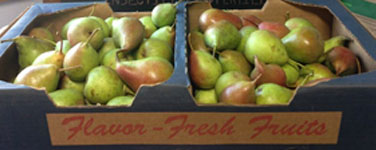
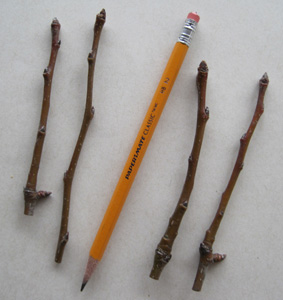 Thankfully
I had cut and saved the smaller pieces with end buds, which should be the pear I
want. I searched around, sharing photos on the GrowingFruit forum, looked at
numerous pictures and descriptions online, but couldn’t find anything that truly
matched this pear. Given the amount of seedlings that were planted, crossings
that were made, testing done, in Canada, Wisconsin, and elsewhere in the early
1900’s, I’m not surprised. These trials were often distributed and/or sold. Also
this is a port town with active shipping and many imports. I’m guessing the
variety will not be found in the trade; that it is unique. For my use I’m
calling it L’Anse pear.
Thankfully
I had cut and saved the smaller pieces with end buds, which should be the pear I
want. I searched around, sharing photos on the GrowingFruit forum, looked at
numerous pictures and descriptions online, but couldn’t find anything that truly
matched this pear. Given the amount of seedlings that were planted, crossings
that were made, testing done, in Canada, Wisconsin, and elsewhere in the early
1900’s, I’m not surprised. These trials were often distributed and/or sold. Also
this is a port town with active shipping and many imports. I’m guessing the
variety will not be found in the trade; that it is unique. For my use I’m
calling it L’Anse pear.